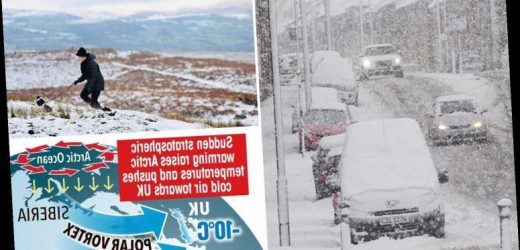BRITS are set to be battered by a Beast from the East this year, as temperatures plunge and "bury Britain in snow."
The first historic storm hit in 2018 when snow blanketed large parts of Britain and temperatures plummeted to as low as -10C.
⚠️ Read our UK weather live blog for the very latest news and forecasts.
It's already been a cold start to the year – with the Met Office issuing ice and snow warnings in the days since New Year's Eve.
But Siberian winds are still pushing in from the east, with the UK expected to see more frost, ice and snow during the rest of the week.
Forecasters are now warning that a 'Sudden Stratosphere Warming' could trigger another Beast from the East on January 11.
Ice warnings are in place today and tomorrow, bringing freezing rain, snow, and icy patches to east and central parts of Scotland and England.
In 2018, Public Health England issued a Level 3 “cold weather action” alert, one step below “national emergency” as major services and power supplies were disrupted.
The winter of 2019 was relatively mild but experts warn this year we might not be so lucky again.
John Hammond from Weathertrending told The Sun Online: "So while last winter was very mild, there are signs that this winter will be quite different.
"Of course some places have already had snow, and much of early December stayed quite cold, with the possibility of further snow in places."
He said the notorious Beast from the East brought record cold temperatures because of a phenomenon called a Sudden Stratospheric Warming – which is when rapid warming occurs 10 to 50km above the earth's surface.
Mr Hammond said: "That caused the 'Polar Vortex' to go into reverse, delivering bitter winds from Siberia, instead of our more usual mild Atlantic winds.
"There are signs that the stratosphere is beginning to ‘misbehave’ again this winter, which may have unpredictable and extreme impacts on our weather later on this winter."
Mr Hammond warned that not every Sudden Stratospheric Warming leads to a Beast from the East but if it did then "the likelihood of a very cold spell of easterly winds would increase markedly".
He added: "With this would come the chance of severe snowfall and extreme cold. – last seen after the Sudden Stratospheric Warming event in late winter 2018.
"So there are lots of ‘ifs, buts and maybes’, and at this stage we can’t be any more specific.
"Of course cold spells can happen without such events in the stratosphere, and the Christmas period does look like turning colder than it is at present."
The Beast from the East in 2018 hit the UK in early March after smashing into Storm Emma.
The lowest temperature recorded during the historic cold spell was -14C in Cairn Gorm in the Scottish Highlands.
At least 19 inches of snow fell on high ground.
It lead to at least 17 deaths in the UK – including a seven-year-old girl in Cornwall.
A 52-year-old homeless man, known as Ben, was also found dead in a tent in Retford, Lincs,.
Three women died also when a Renault Clio collided with a Scania lorry on the A15 in Baston and hours later a man was killed in a three-vehicle smash on the A47 near Peterborough.
Hundreds of drivers were trapped on the snow-battered road between Glasgow and Stirling for 13 hours – with some forced to spend the night in their cars while others abandoned them completely.
Schools were forced to shut and hundreds of flights were grounded.
The 2018 Beast from the East
According to The Met Office, the 'Beast from the East' is a phrase used to describe cold and wintry conditions in the UK as a result of easterly winds from the near continent.
When pressure is high over Scandinavia, the UK tends to experience a polar continental air mass.
When this happens in winter, cold air is drawn in from the Eurasian landmass bringing the cold and wintry conditions that give rise to the 'Beast from the East' moniker.
For UK weather, this means the characteristics of the air depend on the length of sea track during its passage from Europe to the Britain.
The air is inherently very cold and dry and if it reaches southern Britain with a short sea track over the English Channel, the weather is characterised by clear skies and severe frost.
With a longer sea track over the North Sea, the air becomes unstable and moisture is added giving rise to showers of rain or snow, especially near the east coast of Britain.
The UK’s lowest temperatures usually occur in this air mass, lower than minus 10 °C at night, and sometimes remaining below freezing all day.
Polar continental air only reaches Britain between November and April. At other times of the year the source region is neither cold nor snow-covered and winds from north-eastern Europe bring a form of tropical continental air.
Source: Read Full Article














